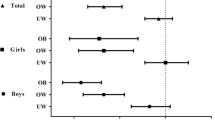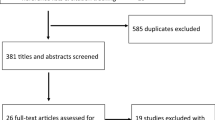Abstract
Background
This study aimed at investigating the association between body mass index (BMI) and the timing of permanent tooth emergence in Jordanian children and adolescents.
Methods
A total of 2,498 Jordanian schoolchildren and adolescents aged 4–16 years were examined for permanent tooth emergence. The BMI was used to classify the subjects into 4 groups: underweight, normal weight, overweight and obese. Probit analysis was used to determine the median age at emergence of each tooth and BMI was used as a factor variable to detect statistically significant differences in the times of tooth emergence within pairs of BMI groups. In addition, binary logistic regression was used to assess the contribution of BMI grouping to the prediction of early emergence for each tooth.
Results
It was found that permanent teeth especially canines, premolars and second molars tended to emerge earlier in children with higher BMIs and later in children with lower BMIs.
Conclusions
This study showed a significant and positive relationship between BMI and earlier emergence of permanent teeth, especially phase II mixed dentition permanent teeth. These findings could be relevant in managing children with varying BMIs in the fields of orthodontics, pediatric and forensic dentistry.
Similar content being viewed by others
References
Diamanti J, Townsend GC. New standards for permanent tooth emergence in Australian children. Aust Dent J. 2003;48(1):39–42.
Eskeli R, Laine-Alava MT, Hausen H, Pahkala R. Standards for permanent tooth emergence in Finnish children. Angle Orthod. 1999;69(6):529–33.
Ghose LJ, Baghdady VS. Eruption time of permanent teeth in Iraqi school children. Arch Oral Biol. 1981;26:13–5.
Wedl JS, Danias S, Schmelzle R, Friedrich RE. Eruption times of permanent teeth in children and young adolescents in Athens (Greece). Clin Oral Investig. 2005;9(2):131–4.
Wedl JS, Schoder V, Blake FAS, Schmelzle R, Friedrich RE. Eruption times of permanent teeth in teenage boys and girls in Izmir (Turkey). J Clin Forensic Med. 2004;11(6):299–302.
Boesen P, Eriksen JH, Helm S. Timing of permanent tooth emergence in two Greenland Eskimo populations. Community Dent Oral Epidemiol. 1976;4(6):244–7.
Friedlaender JS, Bailit HL. Eruption times of the deciduous and permanent teeth of natives on Bougainville Island, Territory of New Guinea: a study of racial variation. Hum Biol. 1969;41(1):51–65.
Garn SM, Wertheimer F, Sandusky ST, Mc Cann MB. Advanced tooth emergence in Negro individuals. J Dent Res. 1972;51(5):1506.
Koyoumdjisky-Kaye E, Baras M, Grover NB. Emergence of the permanent dentition: ethnic variability among Israeli children. Z Morphol Anthropol. 1981;72(3):267–82.
Lavelle CL. Study of tooth emergence in British blacks and whites. J Dent Res. 1976;55(6):1128.
Shaw L, Foster TD. Size and development of the dentition in endocrine deficiency. J Pedod. 1989;13:155–60.
Brin I, Camasuvi S, Dali N, Aizenbud D. Comparison of second molar eruption patterns in patients with skeletal Class II and skeletal Class I malocclusions. Am J Orthod Dentofacial Orthop. 2006;130(6):746–51.
Leroy R, Bogaerts K, Lesaffre E, Declerck D. The effect of fluorides and caries in primary teeth on permanent tooth emergence. Community Dent Oral Epidemiol. 2003;31(6):463–70.
Adler P. Effect of some environmental factors on sequence of permanent tooth eruption. J Dent Res. 1963;42:605–16.
Leroy R, Bogaerts K, Lesaffre E, Declerck D. The emergence of permanent teeth in Flemish children. Community Dent Oral Epidemiol. 2003;31(1):30–9.
Leroy R, Cecere S, Lesaffre E, Declerck D. Caries experience in primary molars and its impact on the variability in permanent tooth emergence sequences. J Dent. 2009;37(11):865–71.
Leroy R, Declerck D. What is the relation between the presence of caries in the deciduous dentition and the chronology of the eruption of the permanent teeth? Rev Belge Med Dent (1984). 2004;59(3):215–21.
Czecholinski JA, Kahl B, Schwarze CW. Early deciduous tooth loss—the mature or immature eruption of their permanent successors. Fortschr Kieferorthop. 1994;55(2):54–60.
Fanning E. Effect of extraction of deciduous molars on the formation and eruption of their successors. Angle Orthod. 1962;32:44–53.
Posen AL. The effect of premature loss of deciduous molars on premolar eruption. Angle Orthod. 1965;35:249–52.
Clements EM, Davies-Thomas E, Pickett KG. Time of eruption of permanent teeth in British children at independent, rural, and urban schools. Br Med J. 1957;1(5034):1511–3.
Garn SM, Nagy JM, Sandusky ST, Trowbridge F. Economic impact on tooth emergence. Am J Phys Anthropol. 1973;39(2):233–7.
Helm S. Secular trend in tooth eruption: a comparative study of Danish school children of 1913 and 1965. Arch Oral Biol. 1969;14:1177–91.
Rousset MM, Boualam N, Delfosse C, Roberts WE. Emergence of permanent teeth: secular trends and variance in a modern sample. J Dent Child (Chic). 2003;70(3):208–14.
Triratana T, Hemindra, Kiatiparjuk C. Eruption of permanent teeth in malnutrition children. J Dent Assoc Thai. 1990;40(3):100–8.
Billewicz WZ, McGregor IA. Eruption of permanent teeth in West African (Gambian) children in relation to age, sex and physique. Ann Hum Biol. 1975;2(2):117–28.
Psoter W, Gebrian B, Prophete S, Reid B, Katz R. Effect of early childhood malnutrition on tooth eruption in Haitian adolescents. Community Dent Oral Epidemiol. 2008;36(2):179–89.
Mierzwinska K. Effect of birth weight on the time of first deciduous tooth eruption in Lublin children. Czas Stomatol. 1984;37(9):659–67.
Udovyts’ka OV, Lepors’ka LB. Relation between the time of eruption of the teeth and the physical development of children. Pediatr Akus Ginekol. 1975;(5):8–9.
Kjellberg H, Beiring M, Albertsson Wikland K. Craniofacial morphology, dental occlusion, tooth eruption, and dental maturity in boys of short stature with or without growth hormone deficiency. Eur J Oral Sci. 2000;108(5):359–67.
Eid RMR, Simi R, Friggi MN, Fisberg M. Assessment of dental maturity of Brazilian children aged 6–14 years using Demirjian’s method. Int J Paediatr Dent. 2002;12(6):423–8.
Hilgers KK, Akridge M, Scheetz JP, Kinane DE. Childhood obesity and dental development. Pediatr Dent. 2006;28(1):18–22.
Shuper A, Shohat M, Sarnat H, Varsano I, Mimouni M. Deciduous tooth eruption in children who fail to gain weight. Helv Paediatr Acta. 1986;41(6):501–4.
Weisell RC. Body mass index as an indicator of obesity. Asia Pacific J Clin Nutr. 2002;11(Suppl):S681–4.
Gallagher D, Heymsfield S, Heo M, Jebb SA, Murgatroyd PR, Sakamoto Y. Healthy percentage body fat ranges: an approach for developing guidelines based on body mass index. Am J Clin Nutr. 2000;72(3):694–701.
Yamashita K, Kondo T, Osugi S, Shimokata K, Maeda K, Okumura N, et al. The significance of measuring body fat percentage determined by bioelectrical impedance analysis for detecting subjects with cardiovascular disease risk factors. Circ J. 2012;76(10):2435.
Centers for Disease Control and Prevention. Gender-specific BMI-for-age growth charts. 2000.http://www.cdc.gov/healthyweight/assessing/bmi/childrens_bmi/about_childrens_bmi.html. Accessed 15 Jan 2013
Ounsted M, Moar V, Scott A. A longitudinal study of tooth emergence and somatic growth in 697 children from birth to three years. Arch Oral Biol. 1987;32(11):787–91.
Sahin F, Camurdan AD, Camurdan MO, Olmez A, Oznurhan F, Beyazova U. Factors affecting the timing of teething in healthy Turkish infants: a prospective cohort study. Int J Paediatr Dent. 2008;18(4):262–6.
Sajjadian N, Shajari H, Jahadi R, Barakat M, Sajjadian A. Relationship between birth weight and time of first deciduous tooth eruption in 143 consecutively born infants. Pediatr Neonatol. 2010;51(4):235–7.
Skelton JA, Cook SR, Auinger P, Klein JD, Barlow SE. Prevalence and trends of severe obesity among US children and adolescents. Acad Pediatr. 2009;9(5):322–9.
Ohrn K, Al-Kahlili B, Huggare J, Forsberg C-M, Marcus C, Dahllof G. Craniofacial morphology in obese adolescents. Acta Odontol Scand. 2002;60(4):193–7.
Shaweesh AI. Timing and sequence of emergence of permanent teeth in the Jordanian population. Arch Oral Biol. 2012;57(2):122–30.
Demographics in Jordan Arabs in Jordan. 2004. http://en.wikipedia.org/wiki/Jordan#Demographics. Accessed 15 Jan 2013
Hawamdeh ZM, Ibrahim AI. Physical growth and nutritional status of Jordanian preschool-aged children. Minerva Pediatr. 2008;60(6):1375–83.
Khader Y, Irshaidat O, Khasawneh M, Amarin Z, Alomari M, Batieha A. Overweight and obesity among school children in Jordan: prevalence and associated factors. Matern Child Health J. 2009;13(3):424–31.
Demirjian A, Goldstein H, Tanner JM. A new system of dental age assessment. Hum Biol. 1973;45(2):211–27.
Albashaireh ZSM, Khader YS. The prevalence and pattern of hypodontia of the permanent teeth and crown size and shape deformity affecting upper lateral incisors in a sample of Jordanian dental patients. Community Dent Health. 2006;23(4):239–43.
Acknowledgements
The elaborate aid of the research assistants Dr. Mohammed M. Algharram, Dr. Mohammad A. Attieh and Dr. Melanie F. Alazzam allowed data collection in less than 3 months.
Grant support: Deanship of Research, Jordan University of Science and Technology, Grant number 113/2007.
Author information
Authors and Affiliations
Corresponding author
Rights and permissions
About this article
Cite this article
Shaweesh, A., Alsoleihat, F. Association between body mass index and timing of permanent tooth emergence in Jordanian children and adolescents. J. Stomat. Occ. Med. 6, 50–58 (2013). https://doi.org/10.1007/s12548-013-0075-x
Received:
Accepted:
Published:
Issue Date:
DOI: https://doi.org/10.1007/s12548-013-0075-x




